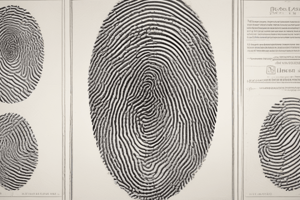Podcast
Questions and Answers
What is an arch in fingerprint patterns?
What is an arch in fingerprint patterns?
- A fingerprint pattern where ridges originate from one side and leave from the other (correct)
- A ridge pattern that flows inward
- A three-dimensional fingerprint made in soft material
- A visible fingerprint with substance on it
What is the definition of a core in fingerprint patterns?
What is the definition of a core in fingerprint patterns?
A center of a loop or whorl.
What is a delta in fingerprint patterns?
What is a delta in fingerprint patterns?
A triangular ridge pattern with ridges that go in different directions.
What is a fingerprint?
What is a fingerprint?
What is a latent fingerprint?
What is a latent fingerprint?
What is a loop in fingerprint patterns?
What is a loop in fingerprint patterns?
What are minutiae in fingerprints?
What are minutiae in fingerprints?
What is a patent fingerprint?
What is a patent fingerprint?
What is a plastic fingerprint?
What is a plastic fingerprint?
What is a ridge pattern in fingerprints?
What is a ridge pattern in fingerprints?
What is a ten card?
What is a ten card?
What is a whorl in fingerprint patterns?
What is a whorl in fingerprint patterns?
Who was Dr. Nehemiah Gray?
Who was Dr. Nehemiah Gray?
Who was Johann Crisoph Andreas Mayer?
Who was Johann Crisoph Andreas Mayer?
Who was Jan Purkyn?
Who was Jan Purkyn?
Who was Sir William Herschel?
Who was Sir William Herschel?
Who was Alphonse Bertillion?
Who was Alphonse Bertillion?
Who was Sir Edmund Richard Henry?
Who was Sir Edmund Richard Henry?
Who was Juan Vucetich?
Who was Juan Vucetich?
How are fingerprints formed?
How are fingerprints formed?
Match the types of fingerprint patterns with their descriptions:
Match the types of fingerprint patterns with their descriptions:
What is the difference between a tented and plain arch pattern?
What is the difference between a tented and plain arch pattern?
Name three different whorl patterns.
Name three different whorl patterns.
Flashcards are hidden until you start studying
Study Notes
Fingerprint Patterns
- Arch: Ridge pattern that enters and exits from opposite sides.
- Core: Central area of a loop or whorl fingerprint.
- Delta: Triangular ridge pattern where ridges diverge above and below a triangle.
- Loop: Ridge pattern that flows inward and then returns outward on the same side.
- Whorl: Bull's-eye fingerprint pattern, characterized by circular ridges.
Types of Fingerprints
- Latent Fingerprint: Hidden prints made visible through powders or techniques.
- Patent Fingerprint: Visible prints created by fingers contaminated with substances like ink or blood.
- Plastic Fingerprint: Three-dimensional impressions left in soft materials like clay or wax.
Fingerprint Characteristics
- Minutiae: Unique details in ridge shapes and positions that distinguish individual fingerprints, also known as ridge characteristics.
- Ridge Pattern: Distinctive arrangement of ridges in fingerprints, classified into arches, loops, and whorls.
Historical Figures in Fingerprinting
- Dr. Nehemiah Gray: First European to publish observations on friction ridge skin in 1684.
- Johann Crisoph Andreas Mayer: Recognized uniqueness of fingerprints in 1788.
- Jan Purkyn: Discussed fingerprint patterns in a 1823 thesis.
- Sir William Herschel: First to use fingerprints for contracts in 1856.
- Alphonse Bertillion: Developed anthropometry; first to identify criminals via fingerprints in the early 1900s.
- Sir Edmund Richard Henry: Created the classification system for fingerprints in 1896 still used today.
- Juan Vucetich: Established the first fingerprint files in 1891 and conducted the first criminal fingerprint identification.
Fingerprint Formation
- Formed around the 10th week of pregnancy due to the rapid growth of the basel layer of the epidermis, leading to unique patterns for identification and functionality.
Fingerprint Classification
- Arches: 5% occurrence; ridges rise in the center and flow out.
- Whorls: 30% occurrence; circular patterns with two deltas.
- Loops: 65% occurrence; ridges enter and exit on the same side.
Arch Patterns
- Tented Arch: 1% occurrence; forms an angle, similar to a loop.
- Plain Arch: 4% occurrence; smooth flow without angles.
Whorl Patterns
- Plain Whorl: 24% occurrence; complete spiral with two deltas.
- Central Pocket Loop Whorl: 2% occurrence; specific configuration yet to be fully detailed.
Studying That Suits You
Use AI to generate personalized quizzes and flashcards to suit your learning preferences.




